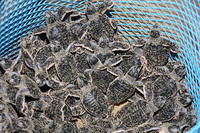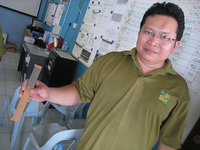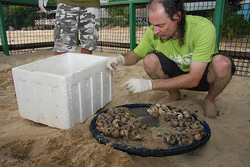Where once sea turtle population took a dive for the worse, one man introduced unusual methods to revive the numbers on Pulau Talang Talang, part of Talang-Satang National Park, Sarawak. Michael Switow talks to Sarawak Forestry official James anak Bali, in a Gaia Discovery exclusive.
Sarawak, 10 September 2011. As I sit on the deck outside the Sarawak Forestry office on Pulau Talang Talang, a small island off the coast of Borneo, watching giant green sea turtles nest in the sand under a clear sky and a full moon, the thought “I am blessed” scrolls through my mind. The turtles, which have slowly dragged themselves up the beach looking for just the right spot, use their rear flippers like shovels, left, right, left, right, to methodically dig deep holes in the sand for their eggs.

Sea turtles return to their birthplace to produce new offspringThese graceful creatures – one of which circled me like a glider as I snorkeled that afternoon – swum the oceans and walked the earth alongside dinousars. The sea here is home to not just the green turtles, but the hawksbill, olive ridley and leatherback as well.
The green turtles in front of me might be 20 old; others could be 80. What's certain is that these reptilian moms return to the same beach once every five years to propagate their species. But despite their clockwork tenacity, the sea turtle population has been decimated by humans – first by Japanese soldiers in World War II who killed the turtles for their meat, then by traders profiting from the sale of sea turtle eggs and fishing trawlers that blindly entrap turtles in their nets.
Conservation officials - like James anak Bali, who was Sarawak's first forestry official to set up camp on Pulau Talang Talang - are fighting back with creative solutions.
Sarawak Forestry advocated for a ban on the sale of all sea turtle eggs, but another government body opposed this effort. The Sarawak Turtle Board argued that eggs laid during the monsoon season never hatched and so there was no point in conserving them. How did you change their mind?
Sarawak started its first sea turtle conservation programme in 1951. But the number of sea turtles in our waters continued to plummet, dropping 90% in 50 years. When we started the current conservation programme in 1996, I had to figure out what had gone wrong before. I'm a marine biologist, so I looked at the issue from a scientific perspective.

One of the first Green turtle hatchlings at P.Talang Talangthings we did was to strengthen the Sarawak Wildlife Protection Ordinance and ban the sale of all turtle eggs to the public. There's a long history of people eating and selling turtle eggs in this region, though. As far back as the 16th century, people from Borneo were trading turtle eggs with China. When we tightened the rules in 1998, another government body called the (Sarawak) Turtle Board continued to sell eggs that were laid during the monsoon season. They argued that monsoon season eggs were not fertile, so there was no point in placing them in hatcheries. Profits from the sale were used to fund the body and for charitable projects.
It was true that rainy season eggs were not hatching. But I didn't believe it was because the eggs had not been fertilised, so I conducted some experiments. Instead of leaving the monsoon season eggs in the nests or burying them in the hatchery, I collected them and placed them in styrofoam boxes. Seventy percent of the eggs hatched.
The problem was not in the eggs, but with our conservation methods. During the monsoon season, the water level increases a lot. Especially during the spring time, the nests can be submerged twice a day. The eggs were not getting the oxygen they need and the embryos were dying.
So the Sarawak Turtle Board agreed to stop selling eggs to the public, but the government conservation authority still has to pay the (Sarawak) Turtle Board two ringgit for every egg.
Sea turtles have also been hit hard by the fishing trawlers that come in and sweep up everything in their path. How are you dealing with this threat?

James anak Bali and team at Pulau Talang Talang help grow sea turtle populationFirst, we did a few studies to identify the areas where turtles liked to rest during their inter-nesting period. Once we located these spots, we conducted sea patrols, but these were not successful, because the fishermen would flee as soon as they saw us. So if patrolling didn't work, what else could we do?
While searching the internet, we came across something called a “reef ball” which was designed to encourage coral growth, attract fish and foster scuba diving spots. Each reef ball weighes about two tons and has a very sharp surface. No one had ever used them to save turtles before, but I had an idea. These reef balls could make it too expensive for the commercial fishing boats to trawl these waters.
We placed clusters of the reef balls in areas where sea turtles like to swim and rest. If a trawler drags its net here, the net becomes entangled and cut by the reef balls. The trawlers end up losing about RM3000-4000 each time. So the commercial boats stay away and we no longer need to do any enforcement.
The local fishermen are very happy though, because without the trawlers encroaching on their traditional fishing grounds, the crabs, fish and shrimp have time to grow larger.
As for the turtles... before we introduced the reef balls eleven years ago, there were at least 70-100 dead sea turtles washed ashore every year. This year, so far only four dead turtles have been recorded in this area.

Writer Michael Switow places turtle eggs gingerly in a waterproof styrofoam box, a solution for waterlogged eggs during the monsoon season
Sarawak Forestry limits the number of tourist who can visit Pulau Talang Talang to just a little over 100 a year. Why is that?
There's a lot of demand by the tourism industry to use sea turtles as a tourism product. People love to see the turtles and they could attract a lot of tourists. But we've learned from other parts of the world. There were spots that were popular for turtle watching. Now, the turtles no longer go there. You might get a lot of money, but even that money is not enough to bring back the turtles, because when you lose them, you lose them forever.
How successful is the Sarawak Forestry sea turtle conservation programme?
We'll have to wait 20 – 30 years to know, because it takes that long for hatchlings to reach maturity and return to the beach to nest. We only started conserving 100% of the sea turtle eggs in 1999. Scientists estimate that out of 1000 hatchlings, only one will survive to be an adult. We don't know for sure, so personally I hope the number is closer to 1 in 100. Either way, we hope that twenty years from now, a lot more turtles will come back to nest here.
Photography by Michael Switow.
Take Action:
A 4-day, 3-night “volunteer” package costs RM3000 (about US$950) including the park permit. Visitors are expected to assist in the hatchery, not just take photos. Accommodation is basic at the Sarawak Forestry Ranger Station. Only six visitors are permitted at one time, 120 visitors per year from May – September.
For more information, contact:
Mr Panch Sammy
Diethelm Travel (Sarawak) Sdn Bhd
No. 257, 2nd Floor, Jln Chan Chin Ann, 93100 Kuching, Sarawak
Tel: 082-41 2778
Adopt-a-Turtle & Adopt-a-Nest
You can assist Sarawak's turtle conservation efforts by adopting a turtle for RM200 or a nest for RM100. Sarawak Forestry will send you a certificate and update you on the turtle or hatchlings.
